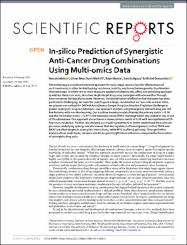3In-silico prediction of synergistic anti-cancer drug combinations using multi-omics data
Abstract
Chemotherapy is a routine treatment approach for early-stage cancers, but the effectiveness of such treatments is often limited by drug resistance, toxicity, and tumor heterogeneity. Combination chemotherapy, in which two or more drugs are applied simultaneously, offers one promising approach to address these concerns, since two single-target drugs may synergize with one another through interconnected biological processes. However, the identification of effective dual therapies has been particularly challenging; because the search space is large, combination success rates are low. Here, we present our method for DREAM AstraZeneca-Sanger Drug Combination Prediction Challenge to predict synergistic drug combinations. Our approach involves using biologically relevant drug and cell line features with machine learning. Our machine learning model obtained the primary metric = 0.36 and the tie-breaker metric = 0.37 in the extension round of the challenge which was ranked in top 15 out of 76 submissions. Our approach also achieves a mean primary metric of 0.39 with ten repetitions of 10-fold cross-validation. Further, we analyzed our model's predictions to better understand the molecular processes underlying synergy and discovered that key regulators of tumorigenesis such as TNFA and BRAF are often targets in synergistic interactions, while MYC is often duplicated. Through further analysis of our predictions, we were also ble to gain insight into mechanisms and potential biomarkers of synergistic drug pairs.

















